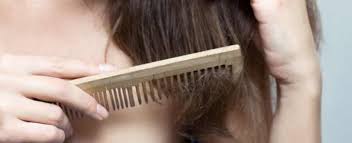For most women, their hair is their crowning glory, and shiny healthy hair makes them feel beautiful and confident. However, if their hair becomes dull, starts thinning or falls out, it will make them feel very anxious and sad.
How Does Our Hair Grow?
All of us were born with hair follicles, from which our hair grows. If we have healthy hair, it will grow at a rate of 1/2 inch per month. Our hair grows according to a cycle, which is divided into three stages, known as anagen, catagen and telogen.
In the first stage, called anagen, the follicles produce healthy hair. This hair can continue growing for up to six years, depending on the hair type, heredity, age, gender and nutrition.
The second stage is called catagen, and it is also known as the transition stage. In the stage, the follicle stops growing hair. Instead, it becomes depleted and is destroyed. This stage will last for 1-2 weeks.
The third stage or telogen is the resting stage. This stage lasts for approximately 2-6 months. When this stage comes to an end, the first stage or anagen starts. The hair follicle will grow a new hair shaft alongside the old hair. Eventually, the old hair will be forced to fall out. You will be relieved to know that telogen only happens on 10-15% of the scalp at any time. That is why you shed around 100 strands of hair per day.

What is Hair Loss?
It is fine to shed a few strands of hair (around 100 strands) per day, but if you noticed that the number of strands left in the sink after grooming or in the shower after washing your hair has increased significantly, you should be worried, especially if the strands all have their hair bulbs intact.
Hair loss happens when the scalp can be seen, the hair looks patchy, or the diameter of the hair looks thinner. Patchy bald spots are also referred to as alopecia. Part the hair in several areas of the scalp to check. The earlier you detected hair loss, the higher your chances for corrective treatment.

What Causes Hair Loss?
According to Trichologists, hair loss is caused by a hereditary condition known as androgenetic alopecia. Androgenetic alopecia affects both men and women, and is also known as male/female pattern baldness. It affects men and women differently. In men, total balding from the front to the crown may happen. In women, balding occurs on the side or crown area of the head, but the hairline usually stays intact. It is estimated that one-third of women suffer from androgenetic alopecia.
Many factors could affect the hair of women, leading to hair loss. Excessive use of strong chemical hair products such as permanent hair dyes, perms, as well as other types of hair products has been found to damage hair. The delicate hair follicles will be damaged, resulting in thinning hair. Also, do not use these products together or close to each other. For example, after perming, hair should not be dyed immediately. In addition, certain hairstyles such as ponytails, cornrows, and pig tails, when done on a daily basis, can also cause hair breakage and even scar the scalp.
There are other factors that could lead to hair loss in women, such as scarring of the follicles, which could be caused by inflammation. The medical term for this condition is cicatricial alopecia. When the hair follicles become damaged, they cannot produce hair and the hair loss will be permanent. Patients suffering from lupus often have inflammation.
Stress could also lead to hair loss. The condition is called alopecia areata and it causes sudden loss of hair in patches. The good news is that this is temporary and hair usually regrows in a few months, provided the stress is under control.
Change in hormonal levels may also lead to temporary hair loss. For example, most women will notice a significant amount of hair falling out after giving birth. When women age and their hormone levels change, they might also experience hair loss.
A lesser known cause of hair loss is hair-pulling or trichotillomania. It is a disorder where patients habitually or compulsively pull out their hair. The cause is usually attributed to psychological factors but the reason is still unknown.


Stem Cell Treatment for Hair Loss
With the advancements in medical technology and treatments, hair loss does not have to be permanent. Hair loss can be reversed without any surgery, hair transplant, pain or downtime.
An option available is stem cell hair treatment. Stem cells are harvested from a 2mm area of the patient’s scalp. It is then processed using a high tech machine to filter and concentrate the stem cells, which are injected into areas of hair loss. The stem cells can reverse hair loss and increase the growth and thickness of new hair.

Before & After Stem Cell Treatment for Hair Loss


Contact Us for a Consultation
Please call/ WhatsApp us at +60-12-662 5552 to make an appointment to see our friendly, highly experienced doctors for a FREE consultation on hair loss treatment. You can also email us at contactus@premier-clinic.com
Our doctors have your best interest at heart and protect your privacy.

